C-C Coupling Reactions between Benzofurazan Derivatives and 1,3-Diaminobenzenes
Abstract
:1. Introduction
2. Results and Discussion
3. Materials and Methods
3.1. General Methods
3.2. Synthesis of 1,3-Di(piperidin-1-yl)benzene (1) and N1,N1,N3,N3-Tetramethylbenzene-1,3-diamine (4)
3.3. Synthesis of 1,3-Dimorpholinobenzene (2) and 1,3-Di(pyrrolidin-1-yl)benzene (3)
3.4. Reactions between (N,N-Dialkyl)-diaminobenzenes (1–4) and Compounds 5–7—General Procedure
4. Conclusions
Acknowledgments
Author Contributions
Conflicts of Interest
References
- Effenberger, F.; Niess, R. N-Persubstituted 3,5-diaminophenols and 1,3,5-benzenetriamines and their protonation. Angew. Chem. Int. Ed. Engl. 1967, 6, 1067. [Google Scholar] [CrossRef]
- Effenberger, F. 1,3,5-Tris(dialkylamino) benzenes: Model Compounds for the Electrophilic Substitution and Oxidation of Aromatic Compounds. Acc. Chem. Res. 1989, 22, 27–35. [Google Scholar] [CrossRef]
- Effenberger, F.; Niess, R. Aminobenzole, IV. N-Persubstituierte 3.5-Diamino-phenole und 1.3.5-Triamino-benzole. Chem. Ber. 1968, 101, 3787–3793. [Google Scholar] [CrossRef]
- Yamaoka, T.; Hosoya, H.; Nagakura, S. Spectroscopic studies on the protonation of s-triaminobenzene. Tetrahedron 1968, 24, 6203–6213. [Google Scholar] [CrossRef]
- Yamaoka, T.; Hosoya, H.; Nagakura, S. Thermochemical studies on the protonation of 1,3,5-triaminobenzene. Tetrahedron 1970, 26, 4125–4130. [Google Scholar] [CrossRef]
- Knoche, W.; Sachs, W.; Vogel, S. Protonation of 1,3,5-tripyrrolidinobenzen, 1,3,5-trimorpholinobenzene and 1,3,5-tripiperidinobenzene in aqueous solution. Bull. Soc. Chim. Fr. 1988, 377–382. [Google Scholar]
- Knoche, W.; Schoeller, W.W.; Schomaecker, R.; Vogel, S. Protonation of 1,3,5-triaminobenzenes in aqueous solutions. Thermodynamics and kinetics of the formation of stable sigma-complexes. J. Am. Chem. Soc. 1988, 110, 7484–7489. [Google Scholar] [CrossRef]
- Sachs, W.; Knoche, W.; Herrmann, S. Protonation of triaminobenzenes in aqueous solution—Reactions involving aromatic compouds, sigma-complexes and cyanine ions. J. Chem. Soc. Perkin Trans. 1991, 2, 701–710. [Google Scholar] [CrossRef]
- Glatzhofer, D.T.; Allen, D.; Taylor, R.W. Protonation of N,N′,N″-triphenyl-1,3,5-triaminobenzenes: Stable sigma-complexes. J. Org. Chem. 1990, 55, 6229–6231. [Google Scholar] [CrossRef]
- Boga, C.; Forlani, L.; Tozzi, S.; Del Vecchio, E.; Mazzanti, A.; Monari, M.; Zanna, N. A Proton Dance: Wheland Complexes and Ammonium Salts Obtained from Organic Acids and 1,3,5-Tris(N,N-dialkylamino)benzene Derivatives. Curr. Org. Chem. 2014, 18, 512–523. [Google Scholar] [CrossRef]
- Menzel, P.; Effenberger, F. σ-Complexes in Halogenation of Aminobenzenes—Isolation and Secondary Reactions. Angew. Chem. Int. Ed. Engl. 1972, 11, 922–923. [Google Scholar] [CrossRef]
- Effenberger, F.; Menzel, P.; Seufert, W. Aminobenzole, XV. Halogen-und Pseudohalogen-σ-Komplexe symmetrischer Tris(dialkylamino)benzole-Darstellung und Charakterisierung. Chem. Ber. 1979, 112, 1660–1669. [Google Scholar] [CrossRef]
- Niess, R.; Nagel, K.; Effenberger, F. Stabille ϕ-komplexe-ein beitrag zum mechanismus der aromatenalkylierung. Tetrahedron Lett. 1968, 4265–4268. [Google Scholar] [CrossRef]
- Effenberger, F.; Mack, K.E.; Nagel, K.; Niess, R. Aminobenzole, XI. Alkylierung von 1,3,5-Tripyrrolidinobenzol. Chem. Ber. 1977, 110, 165–180. [Google Scholar] [CrossRef]
- Fkher, P.; Mack, K.E.; Mhsner, E.; Effenberger, F. Aminobenzole, XII. Kinetik und Mechanismus der Alkylierung von 1,3,5-Tripyrrolidinobenzol. Chem. Ber. 1977, 110, 181–198. [Google Scholar]
- Menzel, P.; Effenberger, F. σ-Complex Intermediates in Acylation and Sulfonylation of 1,3,5-Tripyrrolidinobenzene—Preparation, Reactions, and Structure. Angew. Chem. Int. Ed. Engl. 1975, 14, 62–63. [Google Scholar] [CrossRef]
- Effenberger, F.; Agster, W.; Fischer, P.; Jogun, K.H.; Stezowski, J.J.; Daltrozzo, E.; Kollmannsberger-von Nell, G. Synthesis, Structure, and Spectral Behavior of Donor-Accaptor Substituted Biphenyls. J. Org. Chem. 1983, 48, 4649–4658. [Google Scholar] [CrossRef]
- Boga, C.; Del Vecchio, E.; Forlani, L. First evidence for Wheland intermediates in azo-coupling reactions-Reactions between 1,3,5-Tris(dialkylamino)benzene and arenediazonium salts. Eur. J. Org. Chem. 2004, 1567–1571. [Google Scholar] [CrossRef]
- Boga, C.; Del Vecchio, E.; Forlani, L.; Tozzi, S. Evidence of reversibility in azo-coupling reactions between 1,3,5-tris(N,N-dialkylamino)benzenes and arenediazonium salts. J. Org. Chem. 2007, 72, 8741–8747. [Google Scholar] [CrossRef] [PubMed]
- Forlani, L.; Boga, C.; Del Vecchio, E.; Ngobo, A.L.T.D.; Tozzi, S. Reactions of Wheland complexes: Base catalysis in re-aromatization reaction of σ-complexes obtained from 1,3,5-tris(N,N-dialkylamino)benzene and arenediazonium salts. J. Phys. Org. Chem. 2007, 20, 201–205. [Google Scholar] [CrossRef]
- Boga, C.; Micheletti, G.; Cino, S.; Fazzini, S.; Forlani, L.; Zanna, N.; Spinelli, D. C-C coupling between trinitrothiophenes and triaminobenzenes: Zwitterionic intermediates and new all-conjugated structures. Org. Biomol. Chem. 2016, 14, 4267–4275. [Google Scholar] [CrossRef] [PubMed]
- Terrier, F.; Lakhdar, S.; Boubaker, T.; Goumont, R. Ranking the Reactivity of Superelectrophilic Heteroaromatics on the Electrophilicity Scale. J. Org. Chem. 2005, 70, 6242–6253. [Google Scholar] [CrossRef] [PubMed]
- Lakhdar, S.; Goumont, R.; Terrier, F.; Boubaker, T.; Dust, J.M.; Buncel, E. Mayr electrophilicity predicts the dual Diels–Alder and σ-adduct formation behaviour of heteroaromatic super-electrophiles. Org. Biomol. Chem. 2007, 5, 1744–1751. [Google Scholar] [CrossRef] [PubMed]
- Mayr, H.; Patz, M. Scales of Nucleophilicity and Electrophilicity: A System for Ordering Polar Organic and Organometallic Reactions. Angew. Chem. Int. Ed. Engl. 1994, 33, 938–957. [Google Scholar] [CrossRef]
- Mayr, H.; Kempf, B.; Ofial, A.R. π-Nucleophilicity in Carbon−Carbon Bond-Forming Reactions. Acc. Chem. Res. 2003, 36, 66–77. [Google Scholar] [CrossRef] [PubMed]
- Mayr, H.; Patz, M.; Gotta, M.F.; Ofial, A.R. Reactivities and selectivities of free and metal-coordinated carbocations. Pure Appl. Chem. 1998, 70, 1993–2000. [Google Scholar] [CrossRef]
- Mayr, H.; Bug, T.; Gotta, M.F.; Hering, N.; Irrgang, B.; Janker, B.; Kempf, B.; Loos, R.; Ofial, A.R.; Remmenikov, G.; Schimmel, N. Reference Scales for the Characterization of Cationic Electrophiles and Neutral Nucleophiles. J. Am. Chem. Soc. 2001, 123, 9500–9512. [Google Scholar] [CrossRef] [PubMed]
- Mayr’s Database of Reactivity Parameters. Available online: http://www.cup.lmu.de/oc/mayr/ (accessed on 21 February 2017).
- Lakhdar, S.; Westermaier, M.; Terrier, F.; Goumont, R.; Boubaker, T.; Ofial, A.R.; Mayr, H. Nucleophilic Reactivities of Indoles. J. Org. Chem. 2006, 71, 9088–9095. [Google Scholar] [CrossRef] [PubMed]
- Boga, C.; Del Vecchio, E.; Forlani, L.; Goumont, R.; Terrier, F.; Tozzi, S. Evidence for the intermediacy of Wheland-Meisenheimer complexes in SEAr reactions of aminothiazoles with 4,6-dinitrobenzofuroxan. Chem. Eur. J. 2007, 13, 9600–9607. [Google Scholar] [CrossRef] [PubMed]
- Forlani, L.; Boga, C.; Mazzanti, A.; Zanna, N. Trapping and analysing Wheland–Meisenheimer σ complexes, usually labile and escaping intermediates. Eur. J. Org. Chem. 2012, 6, 1123–1129. [Google Scholar] [CrossRef]
- Micheletti, G.; Boga, C.; Pafundi, M.; Pollicino, S.; Zanna, N. New electron-donor and -acceptor architectures from benzofurazans and sym-triaminobenzenes: Intermediates, products and an unusual nitro group shift. Org. Biomol. Chem. 2016, 14, 768–776. [Google Scholar] [CrossRef] [PubMed]
- Jiang, W.; Fu, Q.; Fan, H.; Ho, J.; Wang, W. A highly selective fluorescent probe for thiophenols. Angew. Chem. Int. Ed. 2007, 46, 8445–8448. [Google Scholar] [CrossRef] [PubMed]
- Gunasekara, R.W.; Zhao, Y. Conformationally Switchable Water-Soluble Fluorescent Bischolate Foldamers as Membrane-Curvature Sensors. Langmuir 2015, 31, 3919–3925. [Google Scholar] [CrossRef] [PubMed]
- Wang, L.; Li, C.; Zhang, Y.; Qiao, C.; Ye, Y. Synthesis and Biological Evaluation of Benzofuroxan Derivatives as Fungicides against Phytopathogenic Fungi. J. Agric. Food Chem. 2013, 61, 8632–8640. [Google Scholar] [CrossRef] [PubMed]
- Cerecetto, H.; Porcal, W. Pharmacological properties of furoxans and benzofuroxans: Recent developments. Mini Rev. Med. Chem. 2005, 5, 57–71. [Google Scholar] [CrossRef] [PubMed]
- Gasco, A.; Fruttero, R.; Sorba, G.; Di Stilo, A.; Calvino, R. NO donors: Focus on furoxan derivatives. Pure Appl. Chem. 2004, 76, 973–981. [Google Scholar] [CrossRef]
- Carvalho, P.S.; Maróstica, M.; Gambero, A.; Pedrazzoli, J. Synthesis and pharmacological characterization of a novel nitric oxide-releasing diclofenac derivative containing a benzofuroxan moiety. Eur. J. Med. Chem. 2010, 45, 2489–2493. [Google Scholar] [CrossRef] [PubMed]
- Chugunova, E.; Boga, C.; Sazykin, I.; Cino, S.; Micheletti, G.; Mazzanti, A.; Sazykina, M.; Burilov, A.; Khmelevtsova, L.; Kostina, N. Synthesis and antimicrobial activity of novel structural hybrids of benzofuroxan and benzothiazole derivatives. Eur. J. Med. Chem. 2015, 93, 349–359. [Google Scholar] [CrossRef] [PubMed]
- Hagfeldt, A.; Boschloo, G.; Sun, L.; Kloo, L.; Pettersson, H. Dye-sensitized solar cells. Chem. Rev. 2010, 110, 6595–6663. [Google Scholar] [CrossRef] [PubMed]
- He, G.S.; Tan, L.S.; Zheng, Q.; Prasad, P.N. Multiphoton absorbing materials: Molecular designs, characterizations, and applications. Chem. Rev. 2008, 108, 1245–1330. [Google Scholar] [CrossRef] [PubMed]
- Tolmachev, A.A.; Ivonin, S.P.; Kharchanko, A.V.; Kozlov, E.S. C-phosphorylation of N-arylmorpholines. J. Gen. Chem. USSR 1992, 62, 868–871. [Google Scholar]
- Effenberger, F.; Gleiter, R.; Heider, L.; Niess, R. Aminobenzole, III. Reaktion aktivierter Aromaten mit Isocyanaten. Chem. Ber. 1968, 101, 502–511. [Google Scholar] [CrossRef]
- Sachs, F.; Appenzeller, E. Über den Tetramethyl-2.4-diaminobenzaldehyd. Ber. Dtsch. Chem. Ges. 1908, 41, 91–108. [Google Scholar] [CrossRef]
- Terrier, F. Modern Nucleophilic Aromatic Substitution; Wiley VCH: Weinheim, Germany, 2013. [Google Scholar]
- Terrier, F. Nucleophilic Aromatic Displacement; Feuer, H., Ed.; VCH: New York, NY, USA, 1991. [Google Scholar]
- Kanzina, T.; Nigst, T.A.; Maier, A.; Pichl, S.; Mayr, H. Nucleophilic Reactivities of Primary and Secondary Amines in Acetonitrile. Eur. J. Org. Chem. 2009, 36, 6379–6385. [Google Scholar] [CrossRef]
- Nigst, T.A.; Antipova, A.; Mayr, H. Nucleophilic Reactivities of Hydrazines and Amines: The Futile Search for the α-Effect in Hydrazine Reactivities. J. Org. Chem. 2012, 77, 8142–8155. [Google Scholar] [CrossRef] [PubMed]
- Basu, B.; Das, P.; Nanda, A.K.; Das, S.; Sarkar, S. Palladium-Catalyzed Selective Amination of Haloaromatics on KF-Alumina Surface. Synlett 2005, 8, 1275–1278. [Google Scholar] [CrossRef]
- Beller, M.; Breindl, C.; Riermeier, T.H.; Tillack, A. Synthesis of 2,3-Dihydroindoles, Indoles, and Anilines by Transition Metal-Free Amination of Aryl Chlorides. J. Org. Chem. 2001, 66, 1403–1412. [Google Scholar] [CrossRef] [PubMed]
- Effenberger, F.; Fischer, P.; Schoeller, W.W.; Stohrer, W.D. The donor strength of dialkylamino functions—A systematic study of δh/hmo π-electron density correlations in aminobenzenes. Tetrahedron 1978, 34, 2409–2417. [Google Scholar] [CrossRef]
- Prabhu, R.N.; Ramesh, R. Synthesis and structural characterization of palladium(II) thiosemicarbazone complex: Application to the Buchwald—Hartwig amination reaction. Tetrahedron Lett. 2013, 54, 1120–1124. [Google Scholar] [CrossRef]
Sample Availability: Samples of the compounds are not available. |
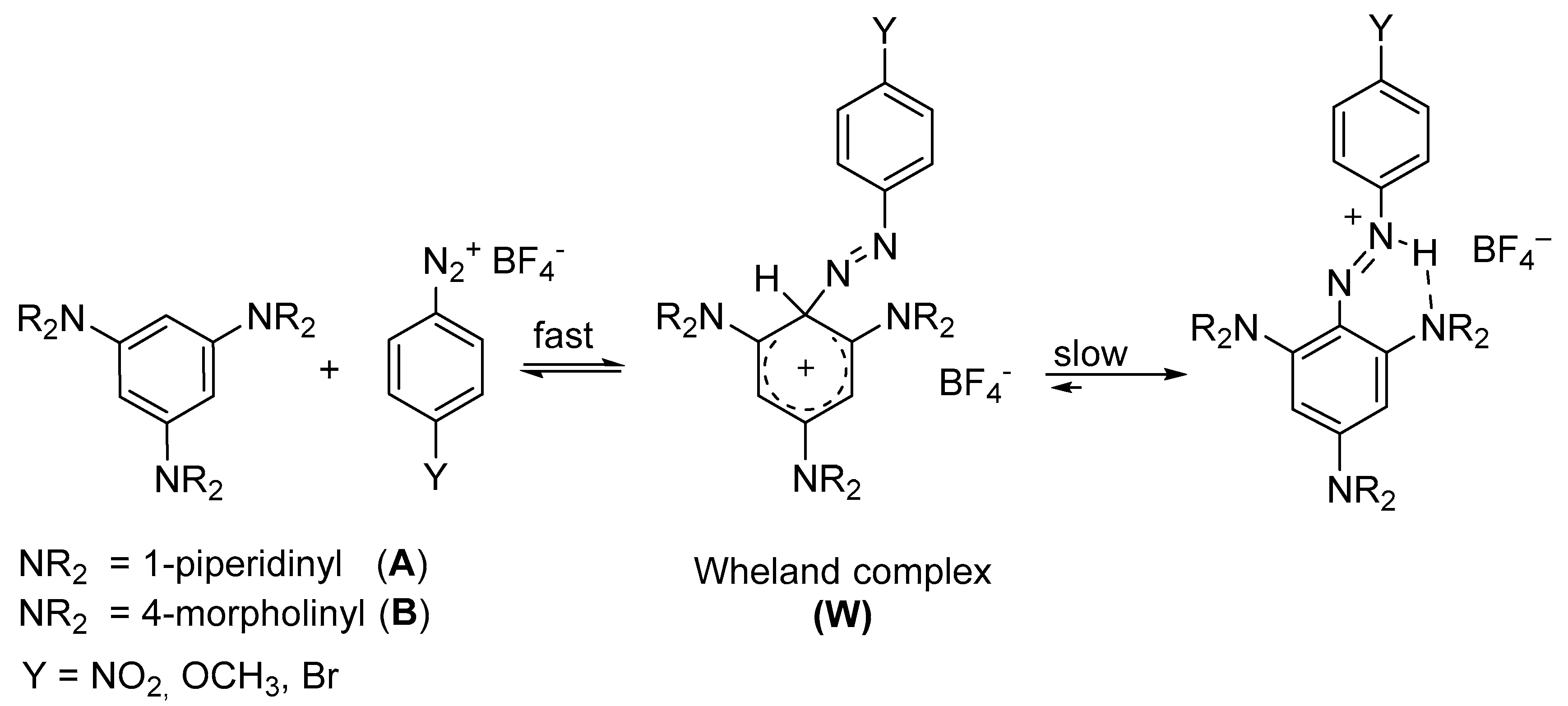

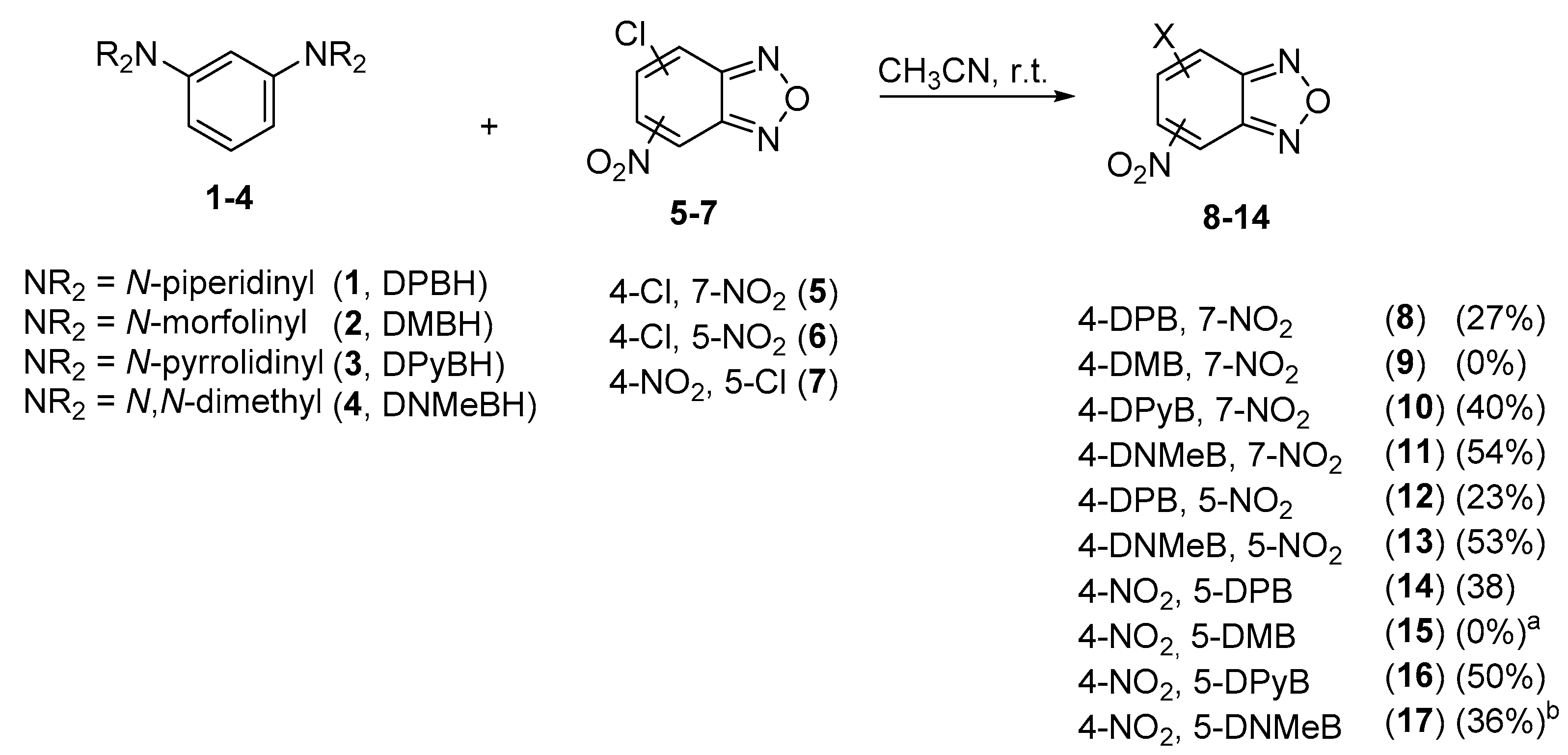

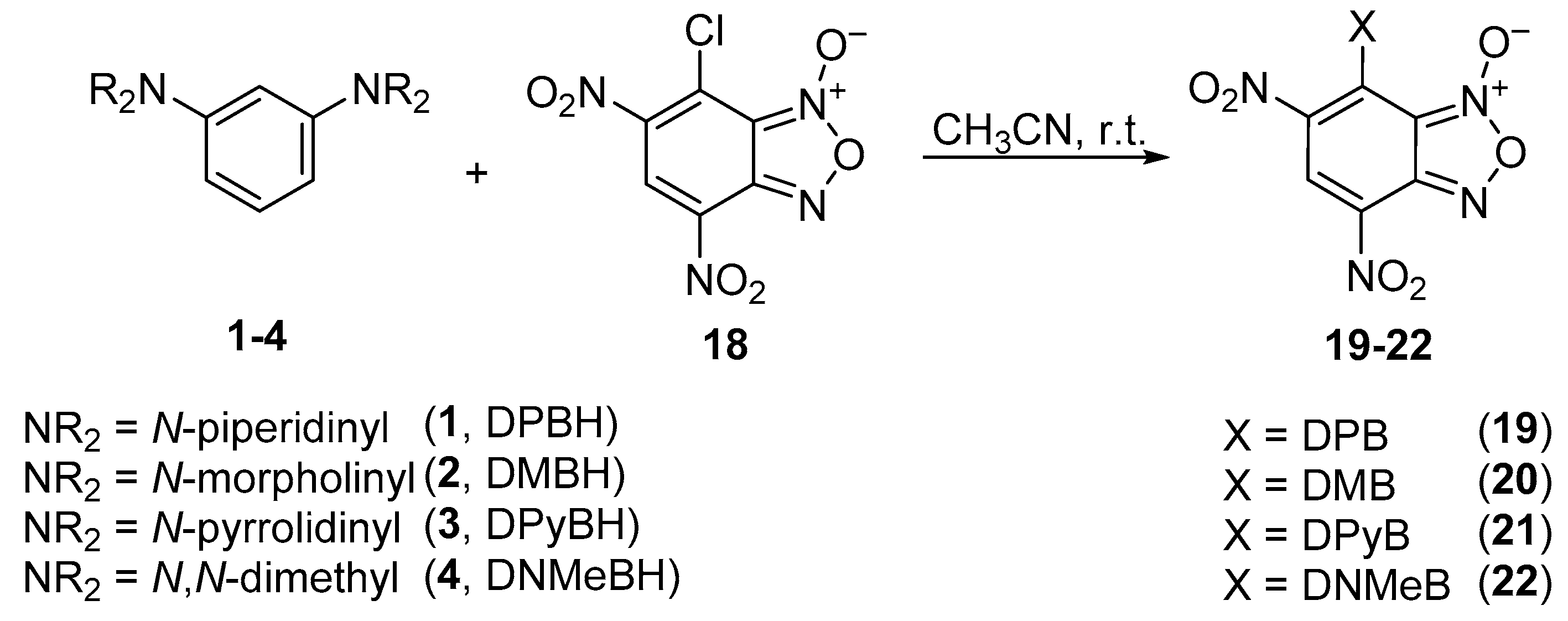
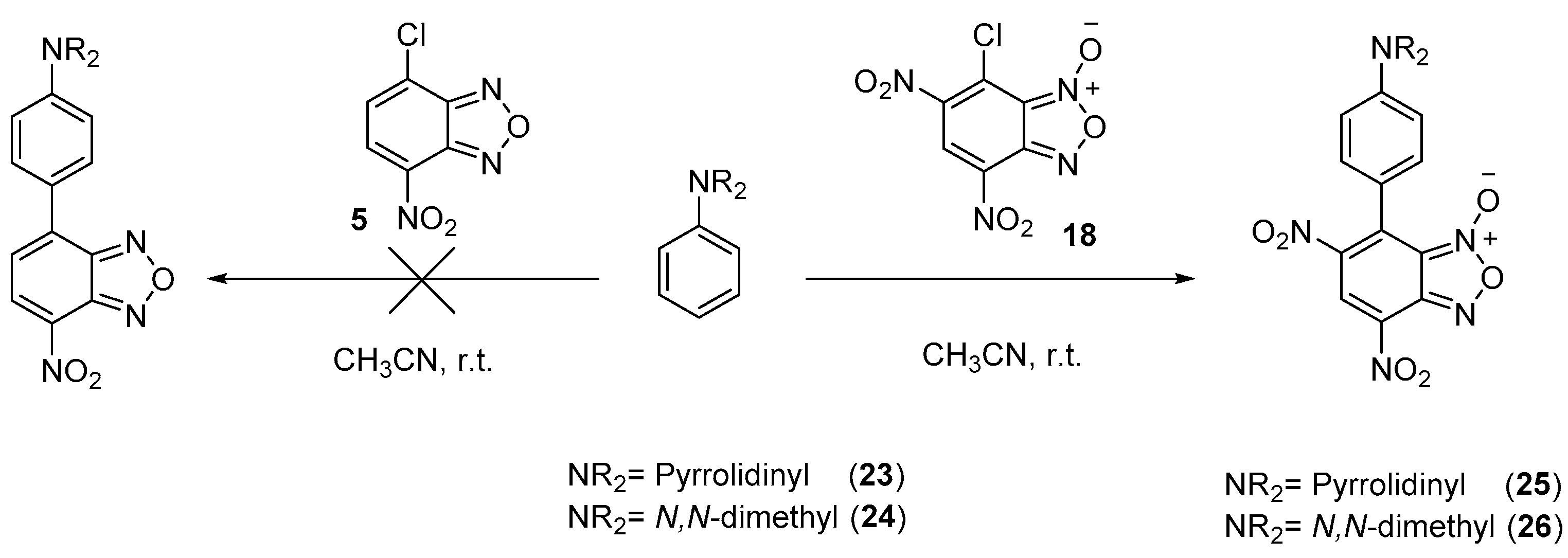
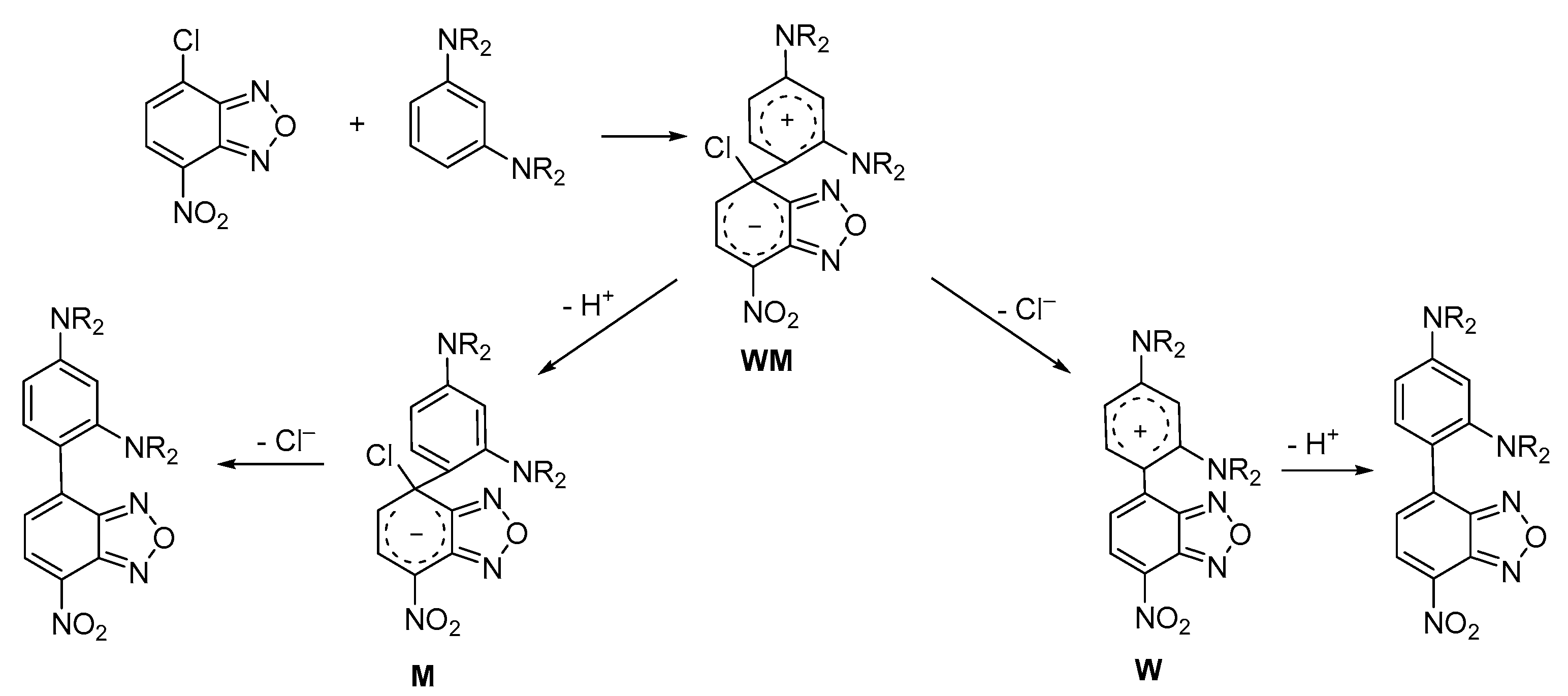
| Entry | Electrophile | Nucleophile | Solvent | Product | 10 min | 2 h | 24 h | 48 h | 72 h |
|---|---|---|---|---|---|---|---|---|---|
| 1 | 5 | DPBH (1) | CDCl3 | 8 | - | 4 | 21 | 26 | 26 3 |
| 2 | 5 | DPBH (1) | CD3CN | 8 | 9 | 12 | 48 | 50 | 52 4 |
| 3 | 5 | DNMeBH (4) | CDCl3 | 11 | 4 | 21 | 40 | 40 | n.c. 5 |
| 4 | 5 | DNMeBH (4) | CD3CN | 11 | 25 | 65 | 73 | 76 | n.c. 5 |
| 5 | 5 | DPyBH (3) | CD3CN | 10 | 42 | 53 | 53 | 56 | n.c. 5 |
| 6 | 7 | DPBH (1) | CD3CN | 14 | 15 | 40 | 55 | n.c. | 60 |
| 7 | 7 | DNMeBH (4) | CD3CN | 17 | 16 | 40 | 55 | n.c. | 55 |
| 8 | 7 | DPyBH (3) | CD3CN | 16 | 35 | 55 | 63 | 70 | n.c. 5 |
| 9 | 18 | DPBH (1) | CD3CN | 19 | 27 | >98 | / | / | / |
| 10 | 18 | DMBH (2) | CD3CN | 20 | 25 | 87 | 95 | >98 | / |
| 11 | 18 | DNMeBH (4) | CD3CN | 22 | 3 | 32 | 87 | >98 | / |
| 12 | 18 | DPyBH (3) | CD3CN | 21 | >97 6 | / | / | / | / |
© 2017 by the authors. Licensee MDPI, Basel, Switzerland. This article is an open access article distributed under the terms and conditions of the Creative Commons Attribution (CC BY) license (http://creativecommons.org/licenses/by/4.0/).
Share and Cite
Micheletti, G.; Bordoni, S.; Chugunova, E.; Boga, C. C-C Coupling Reactions between Benzofurazan Derivatives and 1,3-Diaminobenzenes. Molecules 2017, 22, 684. https://doi.org/10.3390/molecules22050684
Micheletti G, Bordoni S, Chugunova E, Boga C. C-C Coupling Reactions between Benzofurazan Derivatives and 1,3-Diaminobenzenes. Molecules. 2017; 22(5):684. https://doi.org/10.3390/molecules22050684
Chicago/Turabian StyleMicheletti, Gabriele, Silvia Bordoni, Elena Chugunova, and Carla Boga. 2017. "C-C Coupling Reactions between Benzofurazan Derivatives and 1,3-Diaminobenzenes" Molecules 22, no. 5: 684. https://doi.org/10.3390/molecules22050684
APA StyleMicheletti, G., Bordoni, S., Chugunova, E., & Boga, C. (2017). C-C Coupling Reactions between Benzofurazan Derivatives and 1,3-Diaminobenzenes. Molecules, 22(5), 684. https://doi.org/10.3390/molecules22050684










